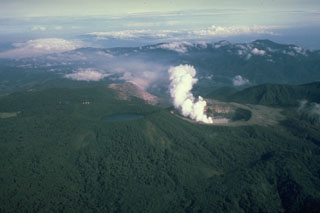Report on Poas (Costa Rica) — 26 March-1 April 2025
Smithsonian Institution / US Geological Survey
Weekly Volcanic Activity Report, 26 March-1 April 2025
Managing Editor: Sally Sennert.
Please cite this report as:
Global Volcanism Program, 2025. Report on Poas (Costa Rica) (Sennert, S, ed.). Weekly Volcanic Activity Report, 26 March-1 April 2025. Smithsonian Institution and US Geological Survey.
Poas
Costa Rica
10.2°N, 84.233°W; summit elev. 2697 m
All times are local (unless otherwise noted)
The Observatorio Vulcanológico y Sismológico de Costa Rica-Universidad Nacional (OVSICORI-UNA) reported increasing activity at Poás in late March with continuing activity at least through 1 April. Significant inflation, phreatomagmatic activity, and volcanic emissions were ongoing. During 23-26 March, small-to-moderate phreatomagmatic explosions at the Boca A and Boca C vents were almost continuous, and they intensified on 24 March. The explosions generated gas-and-steam plumes that rose as high as 150 m and ejected jets of sediments and tephra; material up to 10 cm in diameter was occasionally deposited on the W crater rim. Volcanic gas emissions were very high and indicated that the water content was decreasing while emissions of more toxic gases was increasing. Sulfur dioxide emissions detected in satellite data were as high as 600 tons per day (t/d) on 25 March. Sistema Nacional de Áreas de Conservación (SINAC) closed the Parque Nacional volcán Poás on 25 March. During 25-26 March gas emissions were nearly constant and volcanic plumes drifted E.
On 26 March activity again intensified; during clear conditions ash and bombs were observed being ejected 200 m from the vents and the gas-and-steam plumes contained an increase in ash content. During 27-28 March frequent-to-continuous explosions at Boca C produced gas-and-ash plumes that rose 300-400 m and drifted SW. An explosion at 1558 on 28 March generated a gas-and-ash plume that rose 500 m and drifted W. Activity decreased during the morning of 29 March; small but frequent eruptive events ejected material as high as 50 m and volcanic plumes containing low amounts of ash drifted W. Activity increased in the evening, and during 2030-2315 incandescent bombs were ejected from the vents. A volcanic plume rose 500 m and drifted SW at 2210, and an explosion at 2051 generated a volcanic plume that rose 1 km and drifted W. Ash deposits more than 5 mm deep were observed at the visitor overlook. Significant sulfur dioxide emissions were detected in satellite data. During 30 March-1 April eruptive activity was almost continuous, sulfur dioxide emissions remained high, and ash plumes mainly drifted SW. At 0052 on 31 March a high-energy eruptive event ejected incandescent blocks and material more than 600 m high and generated a gas-and-ash plume that drifted SW and W. Volcanic plumes rose 200 m and drifted NW almost an hour later. Comisión Nacional de Emergencias (CNE) announced an Alert Level Orange for the national park and district of Toro Amarillo in the Canton of Sarchí (including the Desagüe and Agrio river basins) due to increased activity in the crater, ashfall and sulfur odors impacting areas downwind, and a higher potential of lahars in drainages. On 1 April incandescent blocks continued to be ejected from the vents, sometimes as high as 400 m, and ash plumes drifted SW. The Alert Level remained at 3 (the second highest level on a four-level scale) and the Aviation Color Code remained at Orange (the second highest color on a four-color scale).
Geological Summary. The broad vegetated edifice of Poás, one of the most active volcanoes of Costa Rica, contains three craters along a N-S line. The frequently visited multi-hued summit crater lakes of the basaltic-to-dacitic volcano are easily accessible by vehicle from the nearby capital city of San José. A N-S-trending fissure cutting the complex stratovolcano extends to the lower N flank, where it has produced the Congo stratovolcano and several lake-filled maars. The southernmost of the two summit crater lakes, Botos, last erupted about 7,500 years ago. The more prominent geothermally heated northern lake, Laguna Caliente, is one of the world's most acidic natural lakes, with a pH of near zero. It has been the site of frequent phreatic and phreatomagmatic eruptions since an eruption was reported in 1828. Eruptions often include geyser-like ejections of crater-lake water.
Sources: Observatorio Vulcanologico y Sismologico de Costa Rica-Universidad Nacional (OVSICORI-UNA), Comisión Nacional de Prevención de Riesgos y Atención de Emergencias (CNE), Sistema Nacional de Áreas de Conservación (SINAC)

